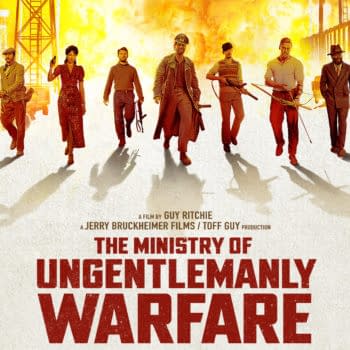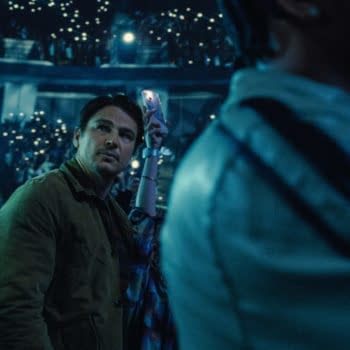Posted in: Movies, Recent Updates, Video Games | Tagged: Alpha Protocol, douglas adams, entertainment, John Buchan, Lara Croft, Obsidian Entertainment, sega, The Thirty Nine Steps, video games
Interactive Story In Gaming – Something Old or Something New?
By Phil Harris
Until recently, the majority of game and other interactive experiences writers have been amateur authors. They came up with an idea, put pen to paper – or at least fingertip to keyboard – and created a world or characters, some of whom, like Lara Croft, have become eponymous with the expanding interactive entertainment sector. Even when published they still often failed to be recognised for the work they did but step-by-step this view is changing and more established authors are becoming involved in the field. But do these experiences use a very new storytelling style, or a very old one?
The reasons that more established writers are becoming interested in the medium is obvious. For the more mercenary amongst them it is clear that many of these experiences make money; but for the majority of others the fact the paper and hardback book format, with its soft touch and musty smell, is slowly becoming a thing of the past means they need to adapt to the new medium so that their stories can be heard and told. There is also an educational issue, as many find the interactive medium far easier to integrate with in the modern day and age, providing a clear and effective bridge to communicate with younger minds in a way they are more comfortable with.
As interactive experiences, and especially games, have grown and become an accepted medium the quality expected from them has also changed. Whilst the best writing and inspiring ideas used to lurk in thick rulebooks and the text heavy adventures of computers in the 80's all these media have been thrust, blinking, into the spotlight. Here they come under the scrutiny of critics, including established authors, and in this rude awakening they are also recognised for their impacts and affects on society. Games like Special Ops: The Line and Skyrim provide us with massively different experiences but are lauded for the worlds they have created and issues which they address.
This "new" mode of storytelling opens up other possibilities too and these are clearly seen in the recent digital adaptation of John Buchan's classic The Thirty Nine Steps. Whilst this is not a game, per se, it does allow the user to play with the environment. So whilst engaging with the story the reader/player can also find out more about the world in which the story is set by highlighting parts of the images used to imagine Buchan's world. This is not the only example of a digital adaptation of fiction. Douglas Adams saw the potential years before and The Hitchhikers Guide to the Galaxy text adventure is a good example of the possibilities; adapting his own dialogue and utilising skills he had already honed in scriptwriting. Perhaps Adams was freer in the medium as he already had experience of adapting his popular story for different formats but we'll come back to that later.
In games themselves there is often more than one medium that the author has to consider. This is no longer just the written word but how this integrates with the rest of the function of gameplay; such as sound, visual style, art, design, direction and programming; not withstanding budget constraints. Even if the writer is involved at the start of the design process and influences the other elements of the game, if the money runs out major scenes relating to the plot may need to be rewritten or simply cut, causing breaks in the dialogue and flow. Worse still for an established author, these changes may be made by someone who has no idea of the story flow the author was initially trying to create – someone with a hatchet, who is being paid to use it.
Given the time it takes to develop many games it is often the case that a hired external writer will not be available or not really want to do rewrites. Revisiting old work a number of years later is the stuff of sequels, not editing for content because the money isn't there, or a new idea has been integrated to the story by the design, art or programming team. It means that writers of games tend to be far less precious about their work on some levels, yet proud of it too, and often expect it to change before launch due to the needs of the medium.
Branched narrative provides even further problems. When a game allows the player the freedom to explore this often leads to them gathering different information and having a separate and unique experience. This branched pathing leads to dialogue often being re-written with subtle nuance and change to help the player gain agency and have their unique story experience: Alpha Protocol provides an excellent example of this, where the player can change their emotional responses to other characters (although the gameplay unfortunately allows this experience to falter). The writer may need to consider alternative endings and possibilities, the fact some players may miss out vast swathes of story for gameplay experience and more.
With these and other issues for interactive story writers to consider the whole process may seem like a bit of a minefield; employing new techniques that sit somewhere between book, script and comic writing whilst also trying to provide a significantly detailed storyline which players can dip into when they want. Whilst the style of modern games is often tied to the Victorian parlor, the writing for games has a far more distant past. A place where deeply religious plays toured the country to teach morals and storytellers and bards would travel from town to town making their living by telling their tales.
In these times the story was not written but passed from one to another. Often in this "passing" the story adapted and changed to reflect the people it was being told to but, if we look at the more established tales which clearly come from the same root – the ones that survived getting lost in the obscurity of time – we can start to consider what was and remains significant. Where they differ is where they have changed to reflect the culture, society and needs of the people that the story is being told to. If two or more versions of the same tale still exist today then we can start to pin down the reasons and make sure the more modern interactive stories reflect this.
If authors and game writers can establish the essential roots of what makes these stories remain popular and integrate them into the experience they are trying to create then they are not really using a new technique but simply rediscovering one from the past. As long as the writing is strong enough to support the other elements of the game, allowing the player the freedom to explore which they are coming to expect, then this must be the first steps on the route to success.
As long as the marketing team does its job!
Phil Harris (@PhilipGHarris) is a games developer who is currently working with One Thumb Mobile on their MMORPG Celtic Heroes and with Pyre Studios on a number of their tabletop game projects. He also writes for Pixels for Breakfast.


















